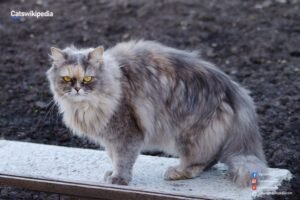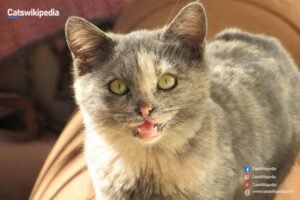DILUTE TORTOISESHELL CAT
The beautiful unique cat is Dilute Tortoiseshell, known for this nickname “Dilute Tortie.” They have diffused pigmentation and two colors within a coat. Compared to cats of a more straightforward coat, these beautiful low-maintenance pets almost enjoy identical health and dieting requirements!
Read ahead to know more about the dilute tortoiseshell cat. This tutorial will tell you everything – from how to care for a dilute tortie to what makes its coat appear diluted. We’ll conclude with six interesting facts about the diluted torties at the end.

DILUTE TORTOISESHELL CAT: AN INTRODUCTION
The cat that is bred with typical double-colored dilute coat pattern is referred to as the dilute tortie or dilute tortoiseshell cat. Very important to note is the fact that the term “dilute tortie” defines a particular cat breed. Instead, it refers to a coloration of the coat which many breeds can carry.
A regular tortie has an orange and black fur coat. The diluted tortie does not have any orange and black coloring. Its bicolor coat is pale in color, often seeming blue and yellow.

Somewhat Tortie Coat
Maybe you would ask how such a diluted tortoiseshell cat gets such an odd coat pattern. Not very easy to understand, after all, but the truth is, the explanation is easy. Maybe you know: the coat of a cat is genetically determined. Diluted torties have that telling, diluted, double-colored pattern because of their special origin.
The genetics can be utilized as a clue towards the understanding of the dilute tortoise coat. At first, it may seem a little confusing, but again, that is worth trying. In the first place, some background about coat genetics needs to be known; it is also very essential. One must understand a fact or two before proceeding into coat genetics – Y and X are two sex chromosomes. The males consist of X and Y, whereas the females hold two X chromosomes.
Let’s start with the genes causing the tortie, or double-colored, coat. These genetic factors apply to the diluted and ordinary torties; let’s focus our discussion here to the diluted torties, which we cover next.
The X chromosome is classified as a sex chromosome. However, it contains much more information about an animal than the simple biological sex of an animal. For instance, it determines the coat color of a cat. Because male cats can have only one coat instruction, which has to be X, females have two, and they can therefore receive two coat instructions-either on both the X or, for domestic cats, one on the X and one not.
If she’s gotten a code for the orange and the black coat, then eventually that female cat will develop one of those tortoiseshell coats with both hues. Meanwhile males receive just one copy of the X chromosome, meaning they’re only given instructions for one hue.

The Five Interesting Facts About Dilute Torties
1. Tortoiseshell Diluted Almost Every Single Cat Is Female.
Because coat color is inherited in genes on the X chromosome, diluted tortoiseshell cats are almost exclusively female. For an animal to have both colors, it must receive two sets of instructions describing the color of its coat. Because this is so, healthy boys receive only one copy of the X chromosome, thus preventing them from developing a tortie coat.
2. Although Men Can Also Inherit the Coat
But a tortoiseshell coat can be inherited to males. Along with the Y chromosome that males are given, they receive two X chromosomes when this happens. This genetic anomaly results in a male tortie cat which has two colors. This is due to the genetic anomaly and for this reason, a male cat with two X chromosomes will have several health issues. Usually, it will not even be able to breed.
It is also known as Klinefelter syndrome. Humans are believed to have it as well. Humans with Klinefelter syndrome are also just as capable of breeding as any animal with Klinefelter syndrome. No matter how hard you may try, you will never, ever be able to breed dilute tortie cats as male cats who carry this gene cannot breed.
3. There Are Several Breeds Where Dilute Tortie Coats Are Possible
At times, people mistake pure breeds with dilute tortoiseshell cat. On the other hand, dilute tortoiseshell cat is defined as a particular combination of coat. This gorgeous coat is found in different breeds. Among all the favorites, American Shorthair, Maine Coon, and Cornish Rex are some of the cats which have the most popular coats that are diluted tortie.
Well, regardless of hair length, this breed can also have such a characterizing coat color. Indeed, it is known that cats with long or short hair are diluted torties.
4. Possibility of an Attitude
As was mentioned previously, many owners of the diluted tortoiseshell cat claim that their cat has the best attitude. However, studies show a cat’s personality is more determined by its environment rather than its coat; although the color of the dog’s coat and aggression do go hand in hand.
Some experts believe that apart from the usual killing spree, the remaining is a result of the hormones of the female. Since more females are violent cats than males, quite obviously it is the hormones rather than any particular coat color who is behind the move.
5. Much Folklore Surrounds Their Habitat
In folklore and mythology, dilute tortoiseshell cat is often the central figure. To illustrate, in Ireland, one believes that a male dilute tortoiseshell cat would bring good luck to a house that one enters. Money cats these felines are called because in the US, the color of a coat is related to prosperity and money.

Final Words
Once again, the term “dilute tortie” refers only to the coat of a cat. This coat type is found in a variety of breeds; however, virtually all cats with diluted tortoiseshell cat are female. You will tend to the same care for your diluted tortie as for any other cat due to the fact that the genes that produce this color result mostly in the cat’s coat. Just be careful of that “fortitude” these kitties are famous for!

